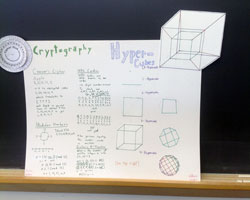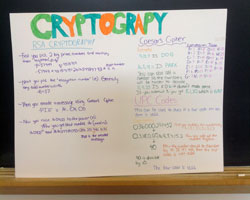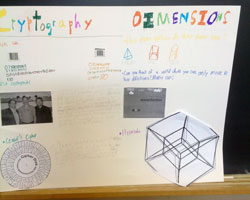Math Explorers' Club (grades 8-12) — Recent Offerings
With support from the National Science Foundation, graduate students have developed a collection of more than 40 mathematics modules that cover a wide variety of topics accessible to middle- and high-school students. We implement one or two of these modules on the Cornell campus each semester in what we call the “Math Explorer’s Club.” The goal of the Math Explorer's Club is to introduce new mathematical concepts and problem solving strategies to grades 8-12 students who will, in turn, communicate their new knowledge in public forums (i.e., through posters and/or presentations).
Details about recent past offerings are included below. The next offering will be announced about a month ahead of time.
Groups around us — fall 2017 (November 4 and 11)
Instructor: Hannah Keese
How can we mathematically capture what it means for an object to be symmetric? How is the summetry of a butterfly different from the symmetry of a starfish? We'll answer these questions and more using a branch of mathematics called group theory, and by physically manipulating objects we'll develop the necessary abstract framework along the way.
About the instructor: Hannah is a second-year graduate student in mathematics. She moved to Ithaca from Australia one year ago and can often be found (fruitlessly) practising her American accent.
Instructor's notes ; Worksheets: (1)everyday, (2)types, (3)counting, (4)putting together, (5)more groups, (6)stars & cyclic groups
Infinity and Paradoxes — spring 2017 (March 11 and 25)
Instructor: Maru Sarazola
Have you ever wondered what would happen if we admitted infinite things into our daily lives? What if your house could have infinitely many rooms, or if you could do things infinitely fast? Come to the Math Explorer's Club to see how our intuition is challenged when infinity comes into play!
About the instructor: Maru Sarazola is a second-year PhD student still trying to figure out her path in the vast world of mathematics. Originally from Uruguay, one thing she likes the most about Ithaca is the squirrels, and she swears she once witnessed a squirrel revolution!
Special Relativity — spring 2017 (February 4 and 11)
Instructor: David Mehrle
Science fiction sometimes makes real science look boring, but Einstein taught us that truth can be stranger than fiction. Come to the Math Explorer’s Club to learn about the speed limit of the universe, the equivalence of energy and matter, and whether or not it’s possible to travel through time.
About the instructor: David Mehrle is a first-year mathematics graduate student, but he thinks physics is cool too. His favorite season is winter, and he wants to keep a mountain goat as a pet.
Instructor's notes ; Worksheets: (1) reference frames, (2) clocks, (3) speed of light, (4) Doppler effect, (5) worldlines
Induction, Recursion, and Beyond — fall 2016 (October 8 and 15)
Instructor: Bertrand Ottino-Loffler
This module will focus on the often maligned and misunderstood proof method: induction. But despite a sometimes mixed reputation, induction remains a ubiquitous and useful mathematical tool. After discussing the concept of a mathematical proof, we'll learn exactly how statements can be rigorously shown using induction — proving results for an infinite number of cases in only two steps. We will build equations, tile a floor, and puzzle through apparent paradoxes. Hope to see you there!
About the instructor: Bertrand Ottino-Loffler is a third year graduate student in the Center for Applied Math, and is doing research in dynamical systems with Prof. Steve Strogatz. He lived in California for four years, and is glad to see winter again.
Handouts: student handouts/worksheets
Big Numbers and Infinity — spring 2016 (January 30 and February 6)
Instructor: Kelsey Houston-Edwards
In this module on infinity, you will learn that infinity is not a number like 2, $10^6$, $\pi$, or 3/4. We need a different set of rules (or ideas) to work with the infinite. Come to the Math Explorer’s Club, where we will discuss paradoxes, infinite arithmetic, and the (infinitely many!) distinct infinities.
About the instructor: Kelsey is a third-year mathematics graduate student studying probability and analysis with Prof. Laurent Saloff-Coste. She grew up in San Diego and has been exploring winter sports since arriving in Ithaca.
Handouts: instructor notes, handout from Jan 30, handout from Feb 6
Geometry and Topology of Surfaces — spring 2016 (March 19 and 26)
Instructor: Chenxi Wu
On the topological side, we will consider examples of simple surfaces like the Mobius strip, torus, and Klein bottle. I will define orientability, Euler characteristic, and state the topological classification of closed surfaces. On the geometry side, I will talk about surfaces that are locally flat except at some cone points (i.e., those that can be made by folding a piece of paper), and use it to illustrate concepts like connection and curvature. Finally, I will discuss the Gauss-Bonnet Theorem for flat surfaces.
About the instructor: Chenxi Wu is a sixth-year graduate student in mathematics working on dynamics of flat surfaces and related fields. He enjoys reading as well as learning and teaching mathematics.
Proof — fall 2015 (October 31 and November 7)
Instructor: Amin Saied
In this module on proof we will explore the crucial idea that is central to all of mathematics! We will learn what a mathematician means she says "proof." When something is proven in mathematics that means it is true beyond any doubt. This is why we still learn about mathematics that was done thousands of years ago (e.g., Pythagoras' theorem). We'll explore some concepts that were proven by mathematicians throughout history and see why their ideas are still used today.
There are two main objectives in this module: (1) To understand what "proof" means: Different types of proofs and arguments, when is a proof is wrong. (2) Exploring new mathematics: We'll learn about new kinds of numbers (like the square root of two), explore the infinite primes, and much more!
About the instructor: I love mathematics! It's fun, powerful and interesting all at the same time. Pursuing this interest has led me to be a fourth year graduate student at Cornell studying (you guessed it!) mathematics. I am originally from the United Kingdom and have been living in the U.S. for almost four years now.
Handouts: instructor notes , student worksheets
Combinatorics — spring 2015 (April 11 and 18)
Instructor: Ernest Chong
What is combinatorics? Wikipedia says combinatorics is a branch of mathematics concerning the study of finite or countable discrete structures, yet many combinatorialists would probably agree that this description is somewhat vague and does not convey the true nature of what combinatorics really is about. In this module, we give a flavor of this subject by introducing a few (of the many) ideas in combinatorics. Whether you have not heard of the word "combinatorics," or you have already read several books on combinatorics, there will be something for everyone. The goal is to learn new "combinatorial" ideas, see familiar ideas in a different light, and realize at the end of the module that combinatorics is not just about "counting things," but much more than that.
About the instructor: Ernest is a 5th year PhD student studying combinatorics. Some of his less boring life experiences are probably quite different than most people's experiences, considering that he once had to navigate on foot through a swamp in Borneo that had crocodiles. Nonetheless, he prefers thinking about math, instead of worrying about crocodiles.
Notes and handouts: insructor notes | worksheet, day 1 | worksheet, day 2
Group Theory — fall 2014 (October 25 and November 1)
Instructor: My Huynh
Group theory is a branch of mathematics that originated in the need to study a broad range of “symmetries” in a unified framework. The purpose of this module is to provide students with lots of hands-on activities to study the special “symmetry” groups, along with necessary tools from set theory and some mathematical abstraction. So what is a group?
About the instructor: I am a third year Ph.D. student studying a special kind of geometry that perhaps you have never heard of called symplectic geometry. I was born and grew up in Vietnam before I immigrated to the US nine years ago. In my free time I love playing soccer and frisbee. I also enjoying traveling very much.
Notes and handouts: What is a group? (lesson plan) | Lesson 1 handout | Lesson 2 handout
Markov Chains — fall 2014 (November 15 and 22)
Instructor: Kelsey Houston-Edwards
In this module about Markov chains, students will learn about random mathematical processes and hopefully apply them in some unexpected ways. We'll figure out where you can expect to end up if you hop on a random airplane, why a wandering bird can get lost forever but a person will always make their way home, and how many times you need to shuffle a deck of cards so they are all mixed up.
About the instructor: Kelsey is a second-year mathematics graduate student studying probability theory with Prof. Laurent Saloff-Coste. She secretly wishes she was a farmer, and spends at least five minutes a day in a headstand.
Elementary Probability and Applications — spring 2014 (March 1 and 8)
Instructor: Lihai Qian
The instructor will briefly introduce probability space and give several examples of discrete and continuous probability. Then he will talk about conditional probability and Markov chains by showing how they work and why they are important in our everyday life.
About the instructor: I am a second year Ph.D. student studying geometry. It's also my second year in the USA, but I've already been to more than 15 states within these two years. Yes, l love traveling, especially the feeling of driving on a seemingly endless road!
Notes and handouts: introduction 1 | introduction 2 | examples | conditional probability | Markov chains | activities
Knot Theory — spring 2014 (March 15 and 22)
Instructor: Ian Pendleton
This module will be an introduction to mathematical knots. We will discuss what it means for two knots to be "the same", and begin looking at partial answers to one of the main questions of knot theory: Given two arbitrary (and possibly very complicated) knots, is there an effective way to tell if they are "the same"?
About the instructor: I am a first year math grad student still trying to find my calling in the wide world of math. I have lived most of my life in California, and this is my first real winter. I absolutely love the snow and insist that there will be a snowman guarding my front yard for as long as the weather will permit it.
Notes and handouts: lesson notes | worksheets
Games and Strategies — fall 2013 (November 9)
What is the similarity between games and life? For both, it's hard to look too far into the future. By putting our thoughts and analysis together in the coming weeks, we will hopefully be able to look farther ahead. We will start by analyzing strategies of simple games like Tic-Tac-Toe with the hope that these strategies will help with other games. If they don't, we can still try to create games for which these strategies are effective. This allows us to better understand the strength and limitation of the strategies as well as the peculiarities of the games.
Module notes for Games and Strategies
Module 1 will be led by math graduate students Chor Hang Lam and Yao Liu. Chor came to the U.S. from Hong Kong as a high school student. In his spare time he likes to play basketball, play computerized musical instruments, and find patterns in games. Yao Liu is a fourth-year math Ph.D. student who also has an interest in natural science (physics in particular), history, and philosophy. Yao enjoys classical music and plays a little bit of violin. He enjoys teaching math, especially inspiring students with facts or insights that they don't normally see in textbooks.
Topology and Geometry of Surfaces — fall 2013 (November 23)
In this module we will explore the world of surfaces-spaces that locally look like the plane. You will learn how to build surfaces and how to tell them apart. Along the way, you will play games like billiards and tic-tac-toe on donuts and Klein bottles. We'll also think about what you'd learn in geometry class if we lived on a different surface!
Module 2 will be led by Kristen Pueschel, a fourth-year mathematics graduate student. Kristen works with Professor Tim Riley in the area of geometric group theory. In her spare time, Kristen loves to garden, read, and tend to her small zoo of pets.
Graph Theory — spring 2013
Margarita Amchislavska and Kristen Pueschel will lead this module. Margarita is a fifth-year mathematics graduate student. She is working with Professor Tim Riley on her dissertation in the area of geometric group theory. Margarita was born in Odessa, Ukraine and moved to the United States when she was 14 years old. In her free time, she enjoys figure skating and playing tennis. Kristen Pueschel is a third-year mathematics graduate student. She is also working with Professor Tim Riley in the area of geometric group theory. Kristen likes to cook, read, and bother her pet hamster, Chumley.
In this module we will introduce graphs from the mathematical point of view. Each lesson will focus on a different application of graph theory in solving real world problems.
Lesson 1: Introduction to graphs
Lesson 2: Graph coloring: friends and strangers problem
Lesson 3: Finding shortest paths in a graph
Lesson 4: Influence models: modeling trends
Lesson 5: Flows and connectivity: optimal transportation of goods
Billiards and Puzzles — spring 2013
Hung Tran and My Huynh will lead this module. Hung originated from Vietnam and completed his undergraduate double degree in mathematics and economics at Berea College in a rural but beautiful Appalachian mountain in Kentucky. Currently, he is working with Professor Xiaodong Cao on geometric analysis, particularly the Ricci flow. Outside of school, he plays various sports including (but not limited to) tennis, ping-pong, badminton, soccer and chess. My Huynh is a first-year mathematics graduate student. He completed his undergraduate degree in mathematics at Arizona State University. He is also originally from Vietnam. In his free time, he enjoys playing video games and soccer.
In this module we will explore some of the mathematics behind billiards, one of the most popular games around the world. It turns out that various features of the game depend largely on the shape of the table, which theoretically can be rectangular, square, circular, elliptical, or some other shape. We will also investigate some puzzles related to billiards, with simple rules but unusual and beautiful solutions!
Lesson 1: Rectangular table
Lesson 2: Circular/Elliptical table
Lesson 3: Triangular table
Lesson 4: Puzzle 1
Lesson 5: Puzzle 2
Posters Prepared by Fall 2012 Participants
Number Theory and Cryptography — fall 2012
Ka Yue (Daniel) Wong, a fifth-year mathematics graduate student, will lead this module. Daniel completed a masters degrees in mathematics from Oxford University. He is working with Professor Dan Barbasch on his dissertation. The focus of his work is representation theory. Daniel is originally from Hong Kong. In his free time, he enjoys playing tennis and bowling.
In this module we will explore one of the oldest disciplines in mathematics — number theory. We will travel through history and look at how Euclid’s algorithm, which was developed more than 2000 years ago, has implications in the modern world of data encryption (e.g., ISBN and UPC codes).
Lesson 1: Congruence and its Applications
Lesson 2: Solving Congruence Equations I
Lesson 3: Solving Congruence Equations II
Lesson 4: Basic Group Theory
Lesson 5: RSA Encryption
Module Notes
This module borrows ideas from material developed by Jason Anema some years ago.
Flat Objects and Optimization — fall 2012
This module will be led by Laura Escobar, a third-year mathematics graduate student. Laura completed her undergraduate degree in mathematics at the Universidad de los Andes in her native country of Colombia in South America followed by a masters degree in mathematics from San Francisco State University. The focus of her dissertation is in the area of algebra and combinatorics under the direction of Professor Allen Knutson. Outside of school Laura enjoys bicycling and reading.
In this module you will learn about flat objects and apply the notion of dimension to these objects. You then will learn about optimization and the relation between optimization and flat objects, which will be generalized to three-space (the world in which we live). Finally, we will learn what happens when you want to find whole numbers solutions to optimization problems, and learn why this is interesting and much more difficult than the problems studied before!
Lesson 1: Dimension and Very Flat Objects
Lesson 2: Polygons in the Plane
Lesson 3: Introduction to Optimization
Lesson 4: Polyhedrons in 3 Space
Lesson 5: Optimization with Whole Numbers as Solutions
Module Notes


